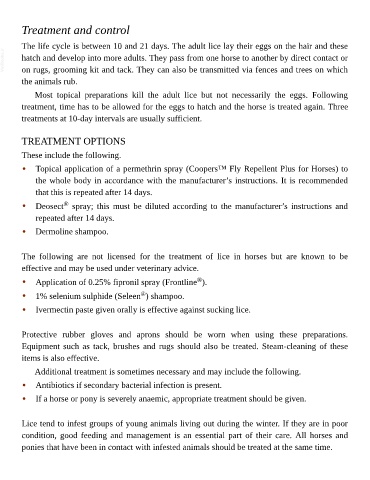Page 842 - The Veterinary Care of the Horse
P. 842
Treatment and control
The life cycle is between 10 and 21 days. The adult lice lay their eggs on the hair and these
VetBooks.ir hatch and develop into more adults. They pass from one horse to another by direct contact or
on rugs, grooming kit and tack. They can also be transmitted via fences and trees on which
the animals rub.
Most topical preparations kill the adult lice but not necessarily the eggs. Following
treatment, time has to be allowed for the eggs to hatch and the horse is treated again. Three
treatments at 10-day intervals are usually sufficient.
TREATMENT OPTIONS
These include the following.
• Topical application of a permethrin spray (Coopers™ Fly Repellent Plus for Horses) to
the whole body in accordance with the manufacturer’s instructions. It is recommended
that this is repeated after 14 days.
®
• Deosect spray; this must be diluted according to the manufacturer’s instructions and
repeated after 14 days.
• Dermoline shampoo.
The following are not licensed for the treatment of lice in horses but are known to be
effective and may be used under veterinary advice.
• Application of 0.25% fipronil spray (Frontline ).
®
• 1% selenium sulphide (Seleen ) shampoo.
®
• Ivermectin paste given orally is effective against sucking lice.
Protective rubber gloves and aprons should be worn when using these preparations.
Equipment such as tack, brushes and rugs should also be treated. Steam-cleaning of these
items is also effective.
Additional treatment is sometimes necessary and may include the following.
• Antibiotics if secondary bacterial infection is present.
• If a horse or pony is severely anaemic, appropriate treatment should be given.
Lice tend to infest groups of young animals living out during the winter. If they are in poor
condition, good feeding and management is an essential part of their care. All horses and
ponies that have been in contact with infested animals should be treated at the same time.

